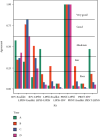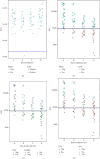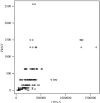The Luciferase Immunoprecipitation System (LIPS) Targeting the Spike Protein of SARS-CoV-2 Is More Accurate than Nucleoprotein-Based LIPS and ELISAs for Mink Serology
- PMID: 40303713
- PMCID: PMC12016994
- DOI: 10.1155/2023/1318901
The Luciferase Immunoprecipitation System (LIPS) Targeting the Spike Protein of SARS-CoV-2 Is More Accurate than Nucleoprotein-Based LIPS and ELISAs for Mink Serology
Abstract
Since anthropo-zoonotic outbreaks of SARS-CoV-2 have been reported in mink farms, it is important to monitor the seroprevalence within this population. To investigate the accuracy of nucleo (N) or spike (S) protein-based assays to detect anti-SARS-CoV-2 antibodies in animal serum, we compared four assays, two commercial N-based enzyme-linked immunosorbent assays (ELISA) validated for animal sera and two luciferase immunoprecipitation systems (LIPS-N and LIPS-S), to the reference standard plaque reduction neutralisation test (PRNT). Samples included in this study were derived from a naturally infected mink population. For the first time in this study, serum samples of mink were collected over a 307-day period, at different time points, thus providing an overview of performances of four different rapid serological tests over time. The assays were compared by performing a correlation analysis using R2, Spearman's rank-order correlation coefficient, and Fleiss' and Cohen's kappa for analysis of agreement to PRNT, and an UpSet chart was created to visualize the number of shared positive samples between assays. Cohen's kappa test on categorical data showed an excellent agreement between PRNT and LIPS-S, while agreements between PRNT and N-based methods decreased from fair for LIPS-N to poor agreements for the ELISA kits. In addition, LIPS-S revealed the highest number of true-positive SARS-CoV-2 samples compared to N-based methods. Despite an excellent agreement between LIPS-S and PRNT, a weak correlation was detectable between PRNT titres and relative light units. This study shows that the LIPS-S assay can be used for serological surveillance within a naturally exposed mink population, while N-based serological assays are less accurate providing a higher number of false-negative results, especially at a later stage of infection, thus indicating that N antibodies are less persistent in naturally exposed mink. Our findings provide crucial information for veterinarians and competent authorities involved in surveillance and outbreak investigation in wild and farmed minks.
Copyright © 2023 Agathe Auer et al.
Conflict of interest statement
The authors declare no conflicts of interest.
Figures





Similar articles
-
Serological Detection of SARS-CoV-2 Antibodies in Naturally-Infected Mink and Other Experimentally-Infected Animals.Viruses. 2021 Aug 19;13(8):1649. doi: 10.3390/v13081649. Viruses. 2021. PMID: 34452513 Free PMC article.
-
A Trans-Governmental Collaboration to Independently Evaluate SARS-CoV-2 Serology Assays.Microbiol Spectr. 2022 Feb 23;10(1):e0156421. doi: 10.1128/spectrum.01564-21. Epub 2022 Jan 12. Microbiol Spectr. 2022. PMID: 35019677 Free PMC article.
-
Serological Assays for Assessing Postvaccination SARS-CoV-2 Antibody Response.Microbiol Spectr. 2021 Oct 31;9(2):e0073321. doi: 10.1128/Spectrum.00733-21. Epub 2021 Sep 29. Microbiol Spectr. 2021. PMID: 34585943 Free PMC article.
-
SARS-CoV-2 infection in farmed minks, associated zoonotic concerns, and importance of the One Health approach during the ongoing COVID-19 pandemic.Vet Q. 2021 Jan 1;41(1):50-60. doi: 10.1080/01652176.2020.1867776. Vet Q. 2021. PMID: 33349165 Free PMC article. Review.
-
Searching for biomarkers: humoral response profiling with luciferase immunoprecipitation systems.Expert Rev Proteomics. 2011 Jun;8(3):309-16. doi: 10.1586/epr.11.23. Expert Rev Proteomics. 2011. PMID: 21679112 Free PMC article. Review.
References
-
- EFSA. European Food Safety Authority and European Centre for Disease Prevention and Control . Parma, Italy: European Food Safety Authority; 2021.
-
- FAO. Animal Production and Health, SARS-CoV-2 in Animals . Rome, Italy: Food and Agriculture Organization; 2022.
-
- Padilla-Blanco M., Aguiló-Gisbert J., Rubio V., et al. The finding of the severe acute respiratory syndrome coronavirus (SARS-CoV 2) in a wild eurasian river otter (Lutra lutra) highlights the need for viral surveillance in wild mustelids. Frontiers in Veterinary Science . 2022;9 doi: 10.3389/fvets.2022.826991.826991 - DOI - PMC - PubMed
MeSH terms
Substances
LinkOut - more resources
Full Text Sources
Medical
Miscellaneous

